Read the blog
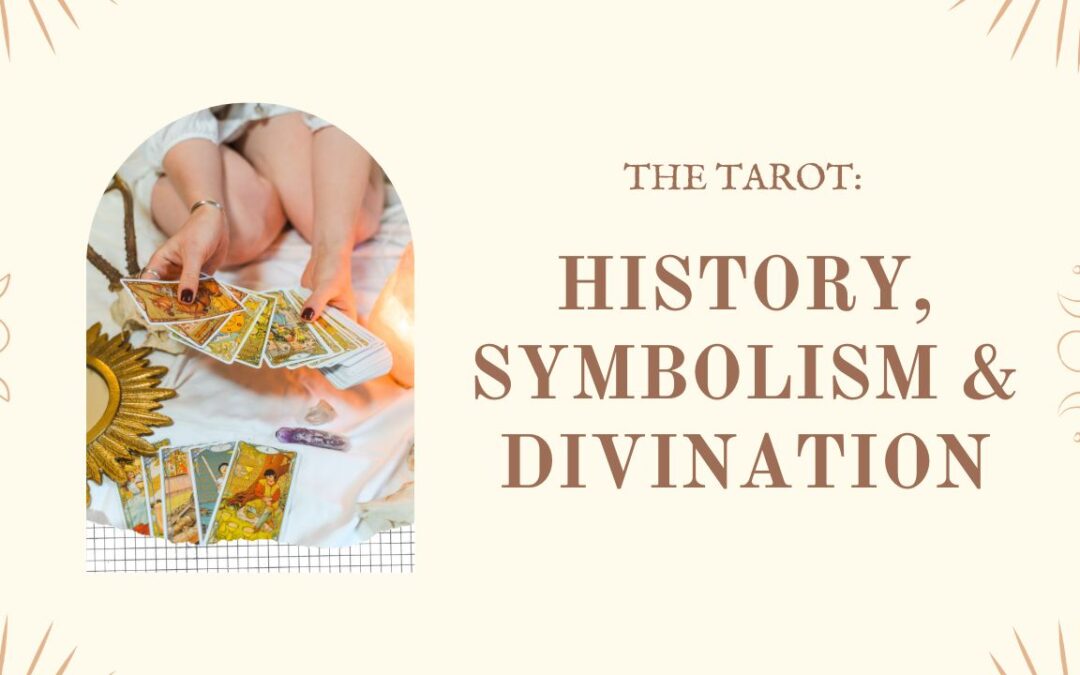
This recontextualized my understanding of tarot
Sometimes I finish a book and immediately start it again. That’s what happened with this one.
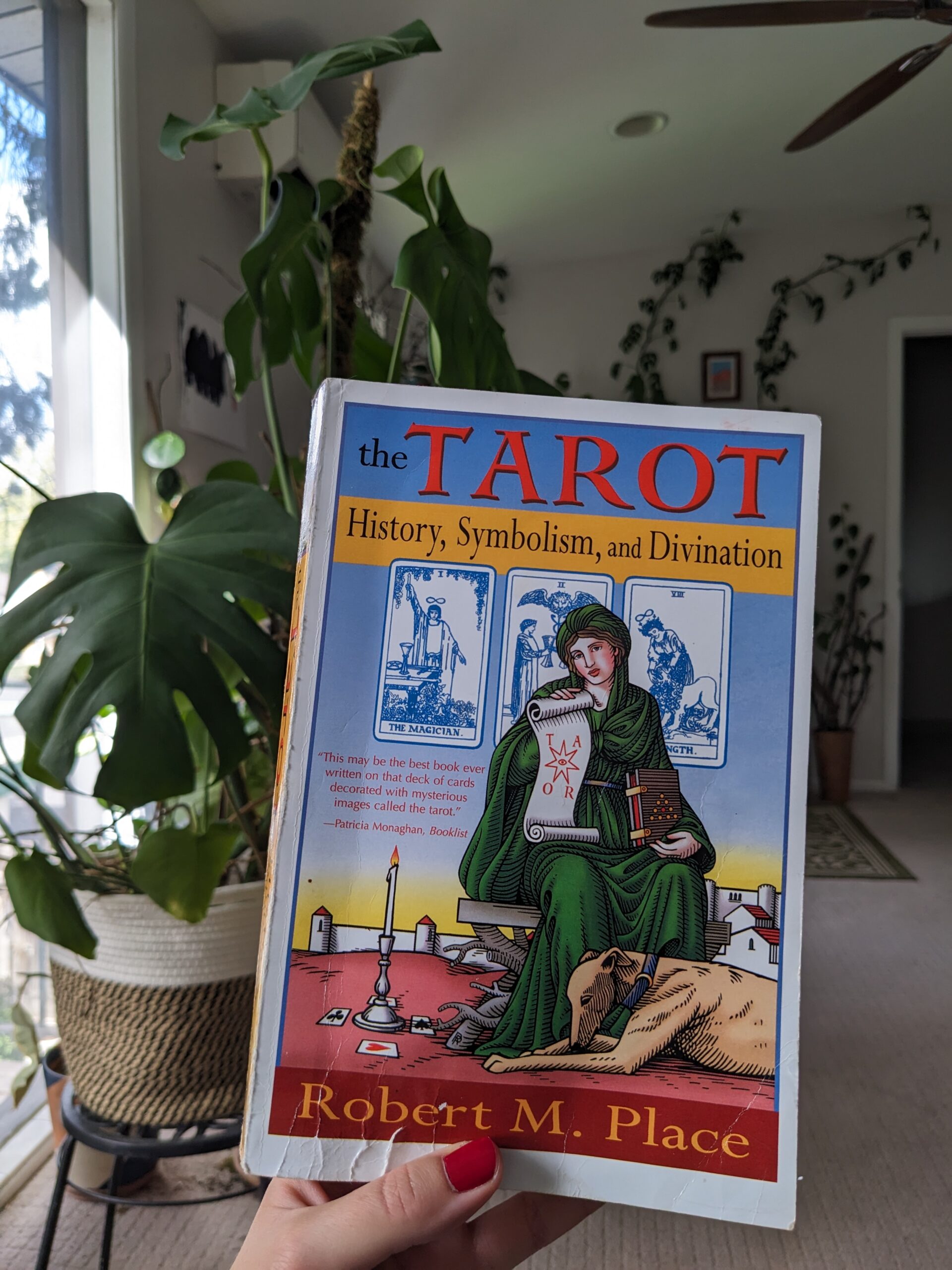
Before I read this, I thought: eh, I know enough about tarot history. I’m not an expert but I can hit on the key points (started as a game in Renaissance Italy, picked up by occultists, blah blah blah). Besides, it’s kind of a boring topic. I’d rather talk about tarot’s present, or tarot’s future.
Turns out that first of all, tarot history is far more fascinating than I thought. Like how the first High Priestess card may relate to a 13th century woman who inspired a heretical movement with the belief that female popes were poised to rise up in the Catholic church. Or how the first occultist to popularize tarot divination was almost denied publication by the royal censor, possibly due to sabotage by another occultist.
And secondly, smart people have said that studying history is the best way to have a better foundation in the present, and a more robust springboard for the future. Guess I have to admit they have a point.
So! Before we go further, a bit of context about this book. Published in 2005, author Robert M. Place draws heavily upon the work of tarot historians Ronald Decker and Michael Dummett (I haven’t read their book A Wicked Pack of Cards: Origins of the Occult Tarot but I know it is widely respected). But this is far from a regurgitation of existing research. With a respect to historical facts, Place comes into this work with the thesis that ‘tarot is like a door that opens onto the Western Mystical Tradition.’ The tone of the book is somewhat academic and no-nonsense, but it still approaches tarot as a tool with authentic mystical value.
The book begins with a punchy section on tarot history. I say punchy because it’s only 26 pages but covers a lot of ground. I’m talking, we start with the invention of paper in 2nd century China and go into the development of playing cards in China, the Islamic world and eventually into Europe. Renaissance Italy is when the deck really became tarot, with the addition of the ‘trump’ cards (ick, can’t type the word trump without wanting to throw up in my mouth a little).
Side note but I found this interesting: at some point Place points out that a lot of what we now know about tarot history was only really verified in the past ~40 years. As its now been ~18 years since this book was published, I’m not sure how much new info has surfaced. But for its time, at least, I think the history info presented here was meticulously researched.
A few things that stood out to me from this first chapter because they really did recontextualize my understanding of tarot: Place clarifies that the Visconti-Sforza cards are the oldest EXISTING tarot cards, but not the oldest KNOWN. These cards were hand painted for the rulers of Milan, likely in the 1450’s, and if you know a bit about tarot history you’ve probably heard of them. There are records that show older decks existed, but they have not survived that we know of. This was news to me because with my very basic understanding of tarot history I was under the impression the Visconti-Sforza did indeed represent the very first tarot decks.
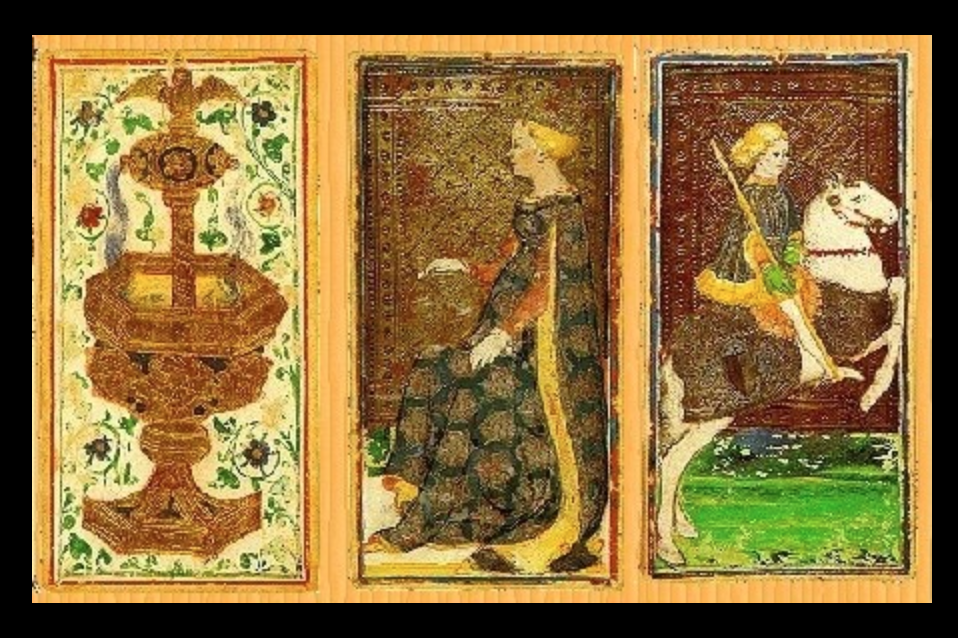
Visconti-Sforza tarot cards, image via Wikipedia
A random thing that fascinated me about the Visconti-Sforza: The Tower, The Devil and the Three of Swords are missing. Well, maybe they are missing, maybe they didn’t even exist in these early decks, Place says there’s no way to know for sure which is the case. Either way I love this idea and as I shared on Threads I think someone could write a great historical fiction about what happened to these cards.
Place pays some attention to the Sola-Busca deck which is another one you might have heard of because it is an early example of more fully illustrated pip cards (vs most older decks that simply show suit tokens for the numbered cards). I knew about the Sola-Busca from Rachel Pollack’s wonderful book Tarot Wisdom and I also knew that it inspired some of Pixie’s illustrations for the Waite-Smith deck several hundred years later. Rachel includes side by side illustrations of both decks, but I was kinda like ‘meh, they don’t look THAT alike.’ I mean, some are very obvious like the Three of Swords. But until Place pointed out some of the more subtle similarities, I didn’t connect the extent of Pixie’s inspiration.
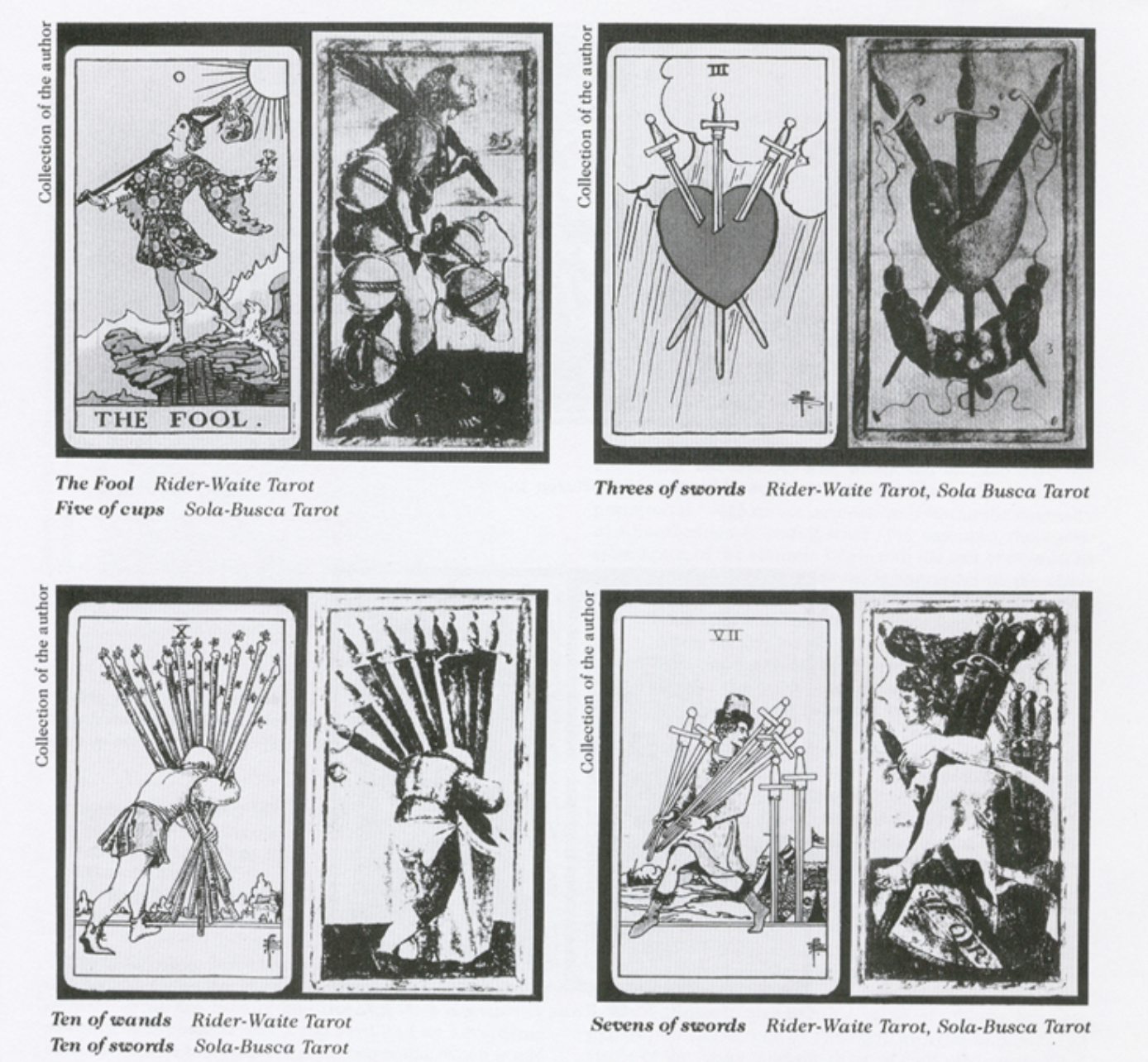
Photos from Stuart Kaplan’s ‘Encyclopedia of Tarot’
Now, with my previously basic understanding of tarot history I’d always believed the oft repeated statement that TAROT STARTED AS A GAME DURING THE RENAISSANCE, and wasn’t used for divination until the occultists got interested a couple hundred years later. But! Place says there is ‘conclusive’ evidence that regular playing cards were used for divination during the Renaissance, and although we may not have definitive proof, it is possible/likely that tarot cards were as well.
Now these are references that come from the 16th century, but Place shares a description of a party game, supposedly played during the Renaissance, where tarot trumps were distributed to guests and everyone else would describe why that card matched that individual. Sounds fun, should we bring this back?
In closing out this first chapter, Place points out that an effort to pinpoint the ‘first’ or ‘true’ tarot is futile. He describes it as a collective art, something that many people have had hands in developing. Very true and this is one thing I love so much about tarot. And the development is ongoing to this day, I say!
The next section of the book, The Mythical History of the Tarot, is where things get even more interesting. Place thoroughly details the tarot lore purported by occultists starting in the 1780s and all the way through the Golden Dawn and the creation of the Waite-Smith deck. I knew some of the basic stuff about Court de Gébelin and Etteilla and how they really started this whole shebang by claiming the tarot had origins in ancient Egypt.
Of course, most modern tarot readers know the supposed Egyptian origins are inaccurate. But I’m not sure most modern tarot readers know that many of the concepts you still work with today were originally put forward specifically by Etteilla in the 1700s. Like, I knew the dude was influential but he seems to be the first to do ALL of these things:
-
use the word cartomancy
-
connect the four suits to the four elements
-
publish a book on tarot divination
-
change the suit of coins to be pentacles, or magical talismans
-
link tarot to astrology
-
introduce the concept of reversed cards
Not bad for a guy who started out as a humble seed merchant. Fun fact: he’s also the one who was almost denied publication by the royal censor, rumor has it this was because of his rivalry with Court de Gébelin.
I won’t go into every interesting thing in this portion of the book because we’d be here all day and you can just like, read the book for that. But it is all quite interesting to see Place attempt to “separate the kernels from the chaff” when it comes to the ideas, hoodwinks and shenanigans of the early occultists.
As I mentioned earlier, this book is meticulously researched and largely concerned with facts. But Place still strongly holds that tarot is indeed a mystical tool. Some of the ideas presented by occultists may not be literally true, but still have symbolic resonance (others are flat out harmful bullshit, so we must be discerning). So here’s where we get into what seems to be the thesis of this book:
Tarot originally developed during the Renaissance. This was a time where many old mystical ideas were being rediscovered and reinterpreted. Some mystics of this time had a particular interest in fusing the teachings of Christianity with the teachings of Plato, in what is now known as Neoplatonism. Place describes several schools of thought which loosely fall under the Neoplatonist umbrella including hermeticism and alchemy, and lays out the case that these concepts were widespread during the Renaissance and it is not unlikely that their influence seeped into the creation of the earliest tarot decks. In Place’s opinion:
Tarot expresses a mystical Neoplatonic philosophy. Specifically, the tarot trumps are an allegory of the soul’s journey to immortality or enlightenment. This allegory is expressed in three groups of seven cards. Symbolically, the number seven is associated with the Neoplatonic ladder of seven planets that forms a stairway by which the soul ascends to the spiritual realm…
The three groups of seven cards allow the sevenfold ladder to be repeated on three levels of increasing spiritual awareness. These three levels are related to Plato’s theory of the three aspects of the human soul.
The tarot also makes use of the triumphant parade as an organizing principle and a metaphor for the triumph of the soul. Tarot is one of numerous works of art from the Renaissance that make use of the same metaphor to express a mystical story…the philosophy expressed in tarot has its roots in ancient mysticism.
Right now I’m trying to stop myself from going on a tangent about the three rows of seven cards thing. This is a concept I’ve been familiar with since my early days as a tarot reader, and it is another thing I was introduced to by Rachel Pollack. It was only through reading this book by Place that I realized some version of this theory has been around since the 1700s, originally introduced by de Gébelin’s colleague de Mellet. It has evolved and been reimagined many times since then, but is still a popular framework for considering the cards today.
Returning to the idea of the ‘triumphant parade’: credit must be given to tarot scholar Gertrude Moakley, who made major breakthroughs in tarot history. While not all of her theories turned out to be correct, she published several bombshell pieces on tarot history during the 1950s and 60s. IT IS A CRIME THAT I HAD NOT HEARD OF HER BEFORE ROBERT M PLACE MENTIONED HER IN THIS BOOK.

Gertrude Moakley, image via tarot-heritage.com
Moakley was the first to suggest that the tarot’s trumps could have originally been related to I Trionfi, the famous 14th century poems by Petrarch which were very popular at the time tarot emerged. The general consensus now is that the cards do not line up perfectly with the poem, but Place believes that nonetheless tarot is part of the same tradition as I Trionfi, which also has heavy Platonic themes.
Moakley also kickstarted the movement to give Pamela Colman Smith credit for her work, and it was Moakley who started referring to the deck as “Waite-Smith” (with it previously being referred to most commonly as “Rider Waite,” Rider being the publisher and Waite being, of course, Arthur Edward Waite).
In the next chapter Place goes into each major arcana card and more thoroughly explores what he believes to be the earliest influences for them. This is where we get the anecdote about the High Priestess (known as the Papesse in these early decks) that I alluded to earlier. Place writes:
“In the 12th century the monk Joachim of Flora had an epiphany… (of a) New Age, in which the Church would be dissolved and individuals would communicate directly with God. His vision inspired the Guglielmites. Their founder, the visionary heretic Gugliema was believed to be an incarnation of the Holy Spirit. Gugliema predicted that in 1300 the New Age would begin and there would be a line of female popes. Her followers elected Sister Manfreda, a relative of the Visconti family, as the first papesse. The inquisition destroyed the sect and although when they found the new papesse she was already dead, they burned her body at the stake. Moakley believes the Visconti-Sforza Papesse card is a portrait of Sister Manfreda.”
Now! Let us not commit the fashionable stupidity of only focusing on the major arcana and not the minors. Place explores the history of the four suits all the way back to the Mamluk decks of the 13th century. Place believes it is likely that the four suits of the Mamluk decks represent aspects of the life of a Mamluk noble (as with the later Italian decks, these decks were created for the wealthy). Place speculates on how the correlations to the four suits may have evolved once the cards reached Europe, and also touches on the various correlations occultists have proposed.
This is as good of a place as any to talk about the terms major arcana and minor arcana. This nomenclature comes to us courtesy of 19th century occultist Paul Christian. This guy was sketchy overall, to be honest. Place notes that the authors of A Wicked Pack of Cards describe him as “that rare thing among those encountered in these pages, a wholehearted charlatan.” He forged evidence connecting tarot to ancient Egypt. Not cool. BUT! He gave us something way better than ‘pips and trumps’ to call deck components and I’m really grateful for that.
Then this book blew my frickin’ mind when it comes to my boy Carl Jung. I had a passing knowledge of Jungian psychology when I first got into tarot. All on my own, I connected the four suits to Jung’s four functions. I was feeling pretty proud of myself until I realized I was FAR from the first person to do this – Jung has been a touchstone to tarot readers since at least the 1960s if not earlier.
So it’s not that Place mentioned Jung’s psychological functions that blew my mind, it’s the way he’s done it. I’ve always seen the correlations as Wands to Intuition, Swords to Thinking, Cups to Feeling, and Pentacles to Sensation. But Robert M Place switches Cups and Wands, attributing Cups to Intuition and Wands to Feeling. At first I was like ‘nah nope no’ but he makes an interesting case for this. According to Place, Jung’s feeling function is commonly misunderstood. This function is not about emotions. It is ‘a decision-making function that determines if something is good or bad and motivates one to action, symbolized by fire.’ I’m not sure I’m converted but I will certainly be thinking more about this.
Sidenote: last year I did a presentation at a tarot conference about the four suits and I talked a lot about Jung’s functions. Maybe someday I’ll record that for YouTube or something. If you’ve read this far and would have an interest in that let me know lol.
Well, well, well. The time has come to talk a little about none other than Arthur Edward Waite.
In some tarot circles it’s become trendy to hate on Waite. And sure, he isn’t above critique. His deck, as influential as it is, isn’t the end all be all. As was stated early, tarot is a collective art, always evolving. Waite is just one of many folks who have had a hand in the development of this collective art, but he really did some important things.
First of all, Waite is sometimes lumped in with all the other early occultists. But he would have hated this, I think. Waite considered himself a scholar and a mystic moreso than an occultist, and he went to great lengths to correct misinformation disseminated by his predecessors. The whole section about Waite’s involvement in the Golden Dawn is fascinating but I won’t regurgitate the whole thing here because again you can just read the book!
I do want to mention a lovely anecdote about Pamela Colman Smith aka Pixie aka the artist behind Waite’s tarot. Place describes her as part of the symbolist art movement and says that while she was illustrating, she would listen to music, go into a sort of trance state, and paint what she saw: “for example, while listening to Beethoven she painted a majestic queen in flowing robes standing on the sea carrying a small ball-like moon in her hands.” I’m not sure this is the piece described but it is a beautiful example of her work either way.
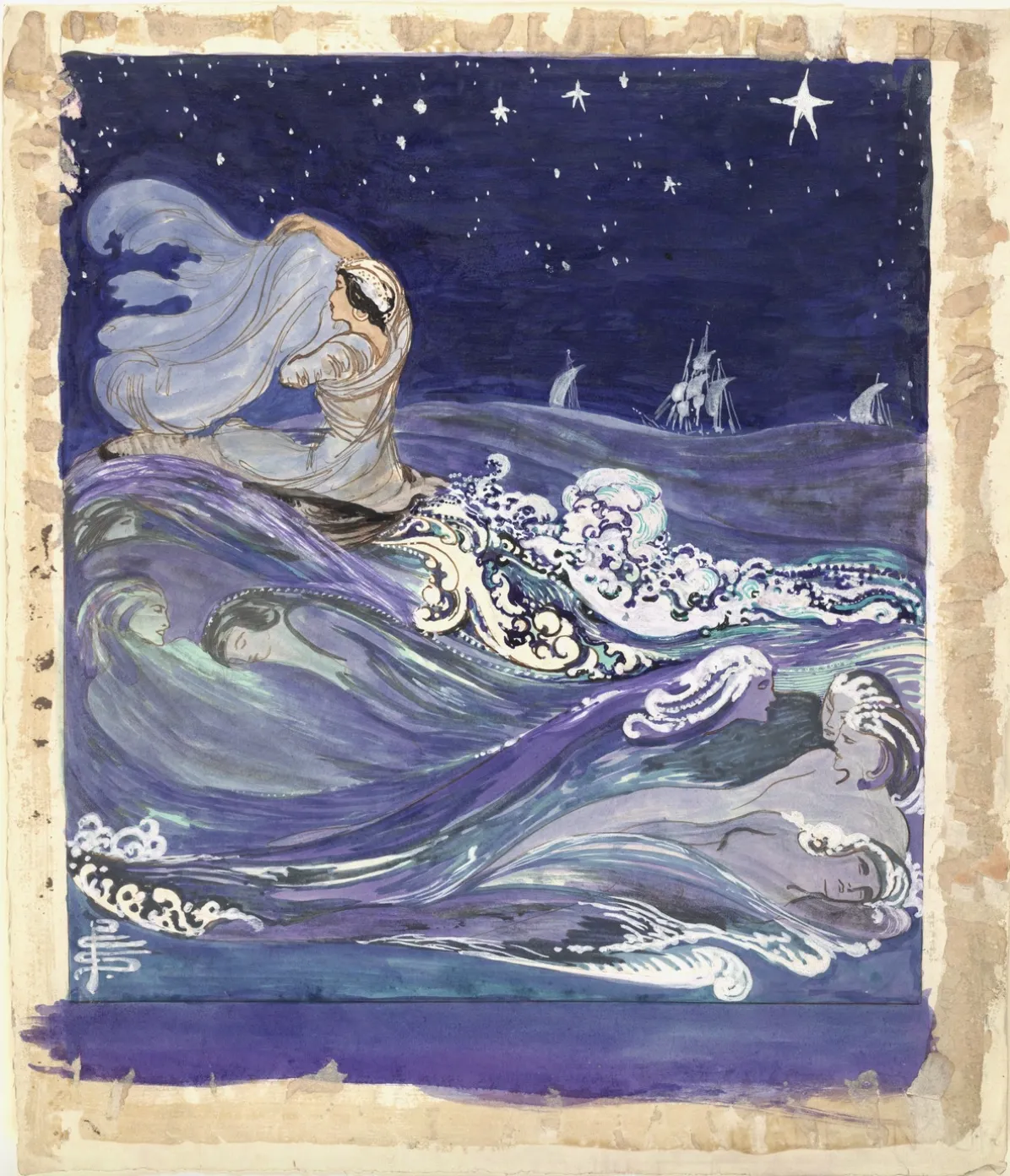
undated watercolor by Pamela Colman Smith
Another fact I learned about the Waite-Smith deck from this book: the entire freakin’ thing seems to have been created in ONLY SIX MONTHS. This is truly…wow. I mean, it took Annie and I three years to create the Spacious Tarot but okay.
Pixie famously wrote to a friend that she “finished a big job for very little cash” and stated she’d completed 80 illustrations for the project. Most people believe the extras were title cards, but this is another thing I mentioned on Threads: what if she created two secret tarot cards that somehow never made it into the deck? Seems unlikely but it’s a fun idea.
The next portion of Place’s book goes through each card in the Waite-Smith individually which to be honest I found kind of unnecessary as many cards get only one or two sentences, but there was some interesting info here.
The final chapter is devoted to the art of actually reading the cards. Place has some very particular methods which I haven’t tried and not sure if I will but I can respect them. He’s pays a lot of attention to directions in his three card spreads, explaining how the way the figures face impacts the ‘flow of energy’ in a reading. If you’re into more systematic methods of interpretation this could be fruitful to try out.
However, despite favoring what to me seems like a more analytic method of reading the cards, Place also highlights the role of intuition. At one point he even says that when you lay out the cards you should:
Interpret (tarot) as you would a dream or a story. At this point, one should forget everything one has learned about the meaning of the cards. Simply look at the layout. Often this causes a momentary panic when one realizes that one does not know what the cards mean. I often feel this myself. This is good, it is a sign that the ego is letting go. Take a deep breath, relax, and simply look at the cards. With patience, the cards will start to make sense in their own way.
Yes! This basically looks like something I would write. Hard agree. And this, my friends, is why I get annoyed at the age old debate of “intuitive vs analytical” tarot readers. Like…we are almost all both??? They can coexist??? I’m very tired of that debate popping up in the tarot community, but I’ve accepted it is something that always rears its ugly head no matter how many times it is addressed.
Well my friends, I need to wrap this up somehow. So what is my conclusion on the book Tarot: History, Symbolism and Divination by Robert M Place?
It is a very good book. I learned a lot and in many ways it really did recontextualize my understanding of tarot. I’m not sure I’m completely sold on Place’s thesis about tarot and Neoplatonism, but I do find it interesting. I think this would appeal most to those of you who want to learn more about tarot history. I don’t think you need to be an expert on tarot history to read the cards, but if you are a tarot nerd as I clearly am you’ll likely find it a compelling read.
So…yeah! That’s my review, I guess. Or at least a bit of a chaotic presentation of my thoughts on this book. A personal note as we wrap up: I haven’t written a long-form piece like this in a while. I miss it, but I’m out of practice. I very much appreciate you reading if you’ve stuck around this far.
As you may or may not have noticed, I’m publishing this on Substack. This is something I’m experimenting with. A lot has changed in the nine years since I started out as a professional tarot internet person. Back then, the norm was that blogging/social media/other content was something you did for free to generate interest in your readings or paid offerings. Now it is possible to get paid for ~creating content~ which I’m not doing yet, but I am interested in this as an option for the future, which is why I’m trying out Substack. If you were already on my mailing list, I’ve imported you here as a FREE subscriber. I hope that’s okay but you can unsubscribe if not!
I love creating and writing about tarot, but I’ve been really inconsistent in my output the past few years because…well…it doesn’t make me money, and because of capitalism, I have to focus more energy on stuff that does. Boo. For now I’m keeping my Substack free to see if I can even manage to stick with it, but that might change in the future. I dunno. Just letting you know for full disclosure, I guess!
One last note on the personal business side of things: my website is still carriemallon.com and eventually I will post Substack pieces onto the blog over there as well. But at the moment I am in a terrible tech nightmare with WordPress where I am unable to update anything on my site. Fingers crossed I can resolve that shortly…
Okay, I’m really done now. I very much appreciate you reading and sharing this new space with me. I hope you found something interesting here and I look forward to connecting with you again soon.
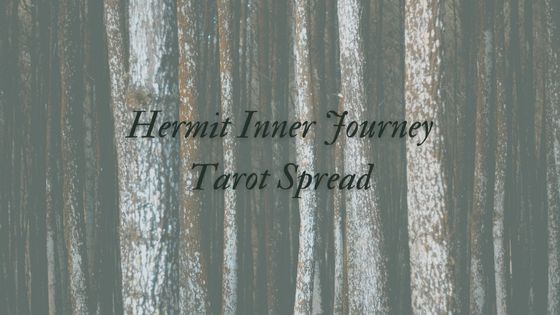
Hermit Inner Journey Tarot Spread
Hello friend,
I hope you are finding many abundant and delightful autumn experiences, if indeed it is autumn where you are. October is one of my favorite months of the year. I’ve been living my best autumn life by taking many long walks, drinking pumpkin beer on the porch, watching Over the Garden Wall, and of course doing tarot things.

It seems like I’ve been very quiet on the internet these days, but I’m lurking around here and there. I’m semi-back on Instagram and occasionally share to stories on my personal account.
But mostly, my focus is on the decks these days. Annie & I launched the Expansion Pack for the Spacious Tarot a couple of months ago so that’s been a whirlwind! I made a video last month talking candidly about the challenges we encountered on this journey.
I also recently shared a free mini-course on how to use the Expansion Pack and I’m slowly adding that series to our blog if you’re interested.
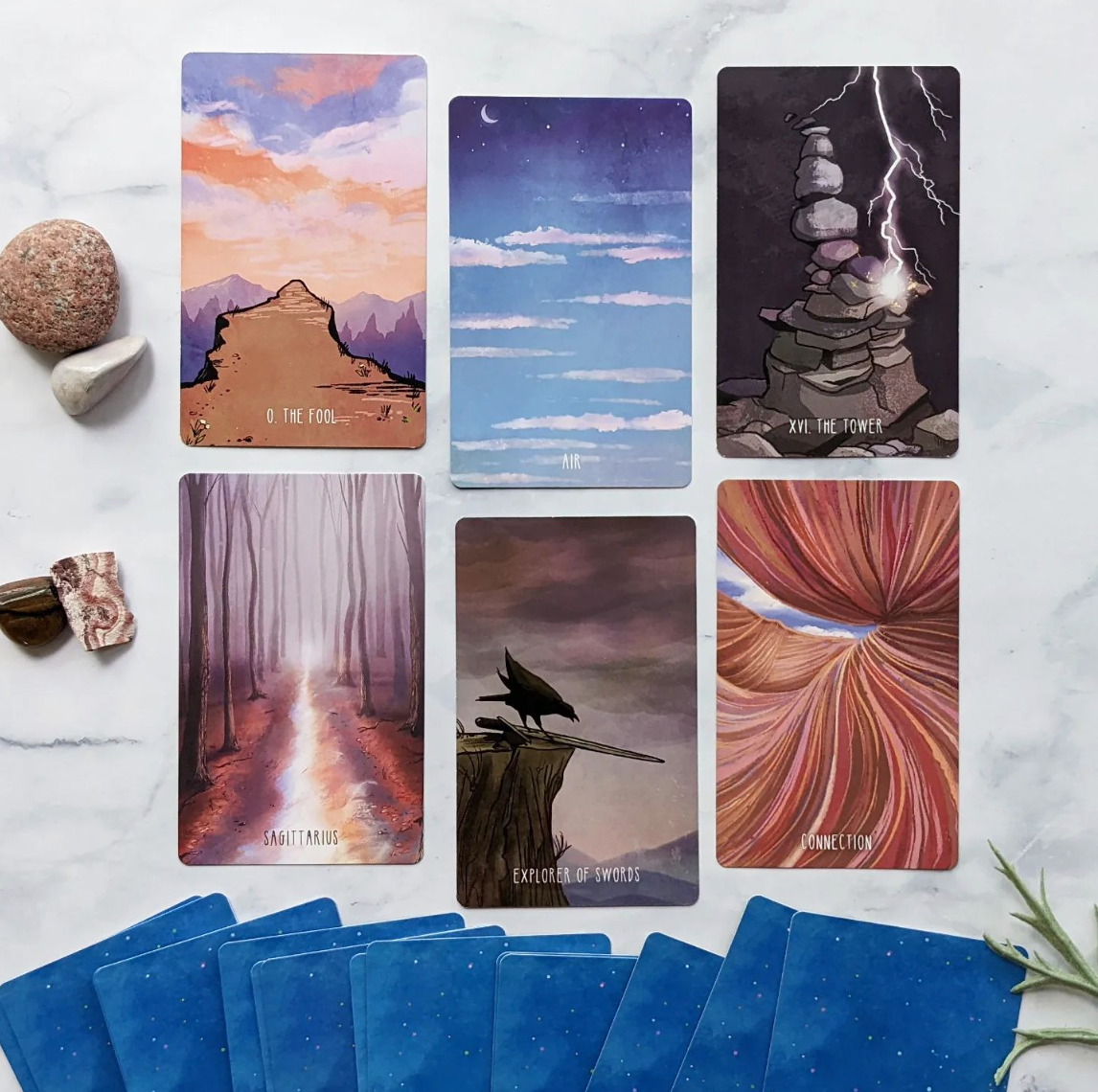
Oh my goodness, every time I look at our cards I feel feelings. They are so beautiful! Wow. How amazing to get to do this with Annie and get to share the cards with some of you. It’s really incredible.
The intensity of launching our second deck has settled down some. And Annie is now on maternity leave as just last week she gave birth to a beautiful baby boy. I’m still doing many deck related things, but I also now find myself with a little more SPACE to expand my focus. So now I’m asking myself: what do I want to focus on next? I have a GIANT to do list, but how do I proceed with it?
One of the things I’m considering taking on is doing National Novel Writing Month again. If you haven’t heard of this, it happens every November and I’ve participated a handful of times. I even wrote a blog series about how to use tarot for NaNoWriMo about a million years ago (okay seven years ago, but still).
So it was perfect timing when I found out my friend Heather Demetrios is teaching a Tarot for Writers workshop later this month (if you register, use code CARRIE and you’ll get 10% off!). Heather also crafted a Hermit Inner Journey tarot spread which you can use for your characters if you’re also a writer. Or, you can do the spread for yourself. I’m going to share the spread with you in a moment.
First, I want to gush a little about Heather. She’s the author of many books, including Little Universes which I absolutely adore. I read this book when it came out a couple years ago and as synchronicity would have it, I was in the middle of a re-read when Heather told me about her upcoming workshop.
I obviously love using tarot for writing, so I’d naturally be intrigued by a Tarot for Writers workshop. But I’m EXTRA excited to endorse this because I adore Heather as a human being and as an author. I also love that she’s created tiered pricing for this so it’s really accessible (plus, again, you’ll get 10% off with code CARRIE).
I am certain Heather will share absolute gems of wisdom during this event, AND she has the credentials to back it up. Her official bio follows:
“Heather Demetrios is a critically acclaimed author, writing coach, and certified meditation teacher based in Saint Paul, Minnesota. Her publishers include Simon & Schuster, Macmillan, and HarperCollins.
She has an MFA in Writing from Vermont College of Fine Arts and is a recipient of the PEN America Discovery Award for her debut novel, Something Real. Her novels include Little Universes, I’ll Meet You There, Bad Romance, as well as the Dark Caravan fantasy series. Her non-fiction includes the Junior Library Guild Gold Standard Selection Code Name Badass: The True Story of Virginia Hall, and she is the editor of Dear Heartbreak: YA Authors and Teens on the Dark Side of Love.
Her honors include books that have been named Bank Street Best Children’s Books, YALSA Best Fiction For Young Adults selections, a Goodreads Choice Nominee, a Kirkus Best Book, and a Barnes and Noble Best Book. Her work has appeared in LA Review of Books, Bustle, School Library Journal, and other fine outlets.
Heather works with writers on integrating mindfulness into their writing practice, process, and life. In addition to being a meditation teacher and Zen Buddhist in the Soto tradition, she holds certificates in Trauma Sensitive Mindfulness and Integrative Somatic Parts (IFS) Work.”
Tarot for Writers is happening live via zoom Wednesday October 26 from 7-9pm EST, with a recording available. Pricing starts at only $35 and you’ll receive a 10% discount with code CARRIE.
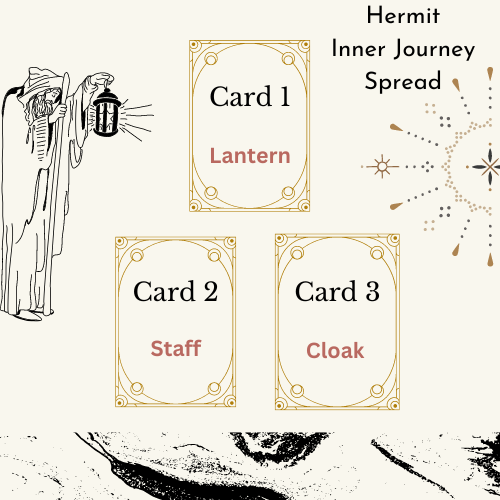
As the spread theme centers on the Hermit, Heather suggests finding this card in the deck and setting it aside as you begin the reading. In this way, the Hermit serves as a guiding energy for the cards you draw (I’m partial to Hermit themed spreads and even designed my own a couple years ago).
As you shuffle, Heather suggests asking “what do I need for my inner journey right now?” Or, of course, “what does my character need for their inner journey?”
Excerpted from Heather’s blog, the positions are as follows:
Lantern: This card represents what energy / forces / resources will be lighting your path as you go inward.
Staff: This card represents the grounding elements and forces in your life that will help you stay on your feet as you traverse this rocky terrain.
Cloak: This card represents the things in your life that will support, protect, and warm you during this journey.
I’ll share some insights I got when doing this spread for myself because…PHEW!
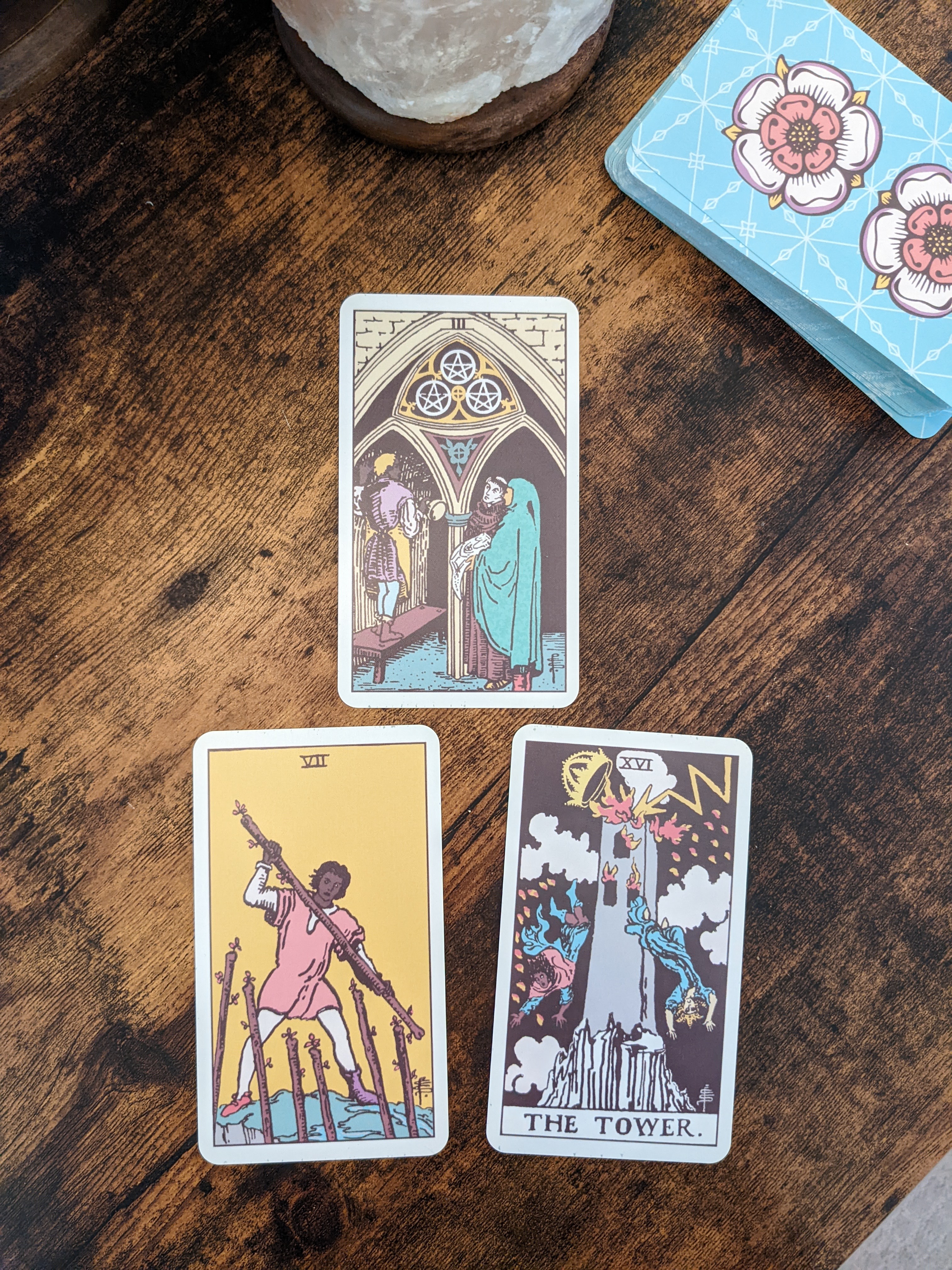
I’m using the Pastel Smith-Waite tarot.
Lantern: Three of Pentacles
Staff: Seven of Wands
Cloak: The Tower
My lantern is the Three of Pentacles. This card is particularly on the nose, as a key theme here is collaboration. And that is certainly a major theme in my life right now. Annie and I are always collaborative, but recently we dedicated some extra time and attention to prepare the business for her to step away and be with her little one. There’s even some meta-commentary here on the fact that by sharing this spread, I’m collaborating with Heather and her creative vision. Besides these factors of my work life, I’m also in the midst of a home project which has required collaborating with neighbors and professionals.
It’s lovely to me that the value of drawing upon others’ knowledge and skills, has arisen in this spread centered around the inner journey. It is truly a gift to know that I have support, that I don’t have to do everything alone. If I DIDN’T have skillful collaborators, I would not have any energy to give to my inner work. Trusting other people to carry some of the load means I can feel safe turning within and being more hermit-y when I need to.
My staff is the Seven of Wands and I actually laughed out loud when I drew this card. I mentioned earlier that I have a giant to-do list. Even as I’ve been writing this post, I’ve been interrupted no less than five times by ‘urgent’ tasks popping up. I quite literally feel like the figure on this card, trying somewhat frantically to keep up with every wand headed my way.
Initially it seems like a strange card to see in this position, but on a deep level it resonates. Heather says this card represents “grounding elements…and forces that will help you stay on your feet.” And I do acknowledge that what I need right now is to be spry to stay on my feet. Instead of being like “oh wah, so many wands, they are going to knock me down, boo hoo,” I need to be in this energy of “I GOT THIS! HERE I GO! BRING IT ON, WANDS!” Because the fact is everything that is currently on my to-do list got there because I said yes to it.
And going back to the message of the first card, I need to discern between what I need to step up and do myself, and what I can seek assistance with.
Another powerful message I’m getting from the Seven of Wands here: I have a tendency to push off tasks that when I finally end up doing them take like…ten minutes. Instead of just bursting out like the figure on this card and handling it, I can actually waste a TON of energy by not handling things. Weirdly, sometimes avoiding things is actually more energetically draining than just knocking them out. Even though this spread is centered on the inner journey, this is another reminder that my inner + outer world are inextricably linked. Paradoxically, sometimes it is by engaging with tasks in the outer world that I find transformation in my inner world.
So that’s my key message here: in order to be grounded, I need to just knock things out. If I’m saying yes to something, then say YES to it and blast through it. This is actually…exactly what I needed to hear right now, to be honest.
Now I have the Tower as my cloak. HA! Oh, the Tower. Me and this card go way back. It’s actually one of my favorite cards, even though it can at times be difficult. Here’s what I’m getting with this card in this spread: the thing that will support and protect me is knowing that upheaval is truly a constant in life. That doesn’t mean I don’t deserve peace. But I do have a tendency to avoid doing certain things because I’m waiting for things to “calm down” before I proceed.
In this way, the Tower and the Seven of Wands bring a similar message: life is chaotic. And that’s okay. There’s tremendous power in accepting chaos. In fact, sometimes I wonder if by resisting chaos I actually draw more of it in. Maybe by embracing the cloak of the Tower I can work WITH the chaos, let it flow through me. Because chaotic energy and creative energy are inextricably linked.
Thank you to Heather for sharing this spread. Doing it for myself it did not bring up what I expected, but I feel it brought up exactly what I needed. I can’t wait to use this spread to get to know the characters in my next writing project! If you want to learn many more ways to use tarot in your writing, Heather’s Tarot for Writers is bound to be helpful. And one last time: you’ll get 10% discount with code CARRIE.
Thank you for being here and I hope to be in touch again soon.
Begin or deepen your tarot studies with
Foundational Tarot, my free video course!
Join the email list for instant access.
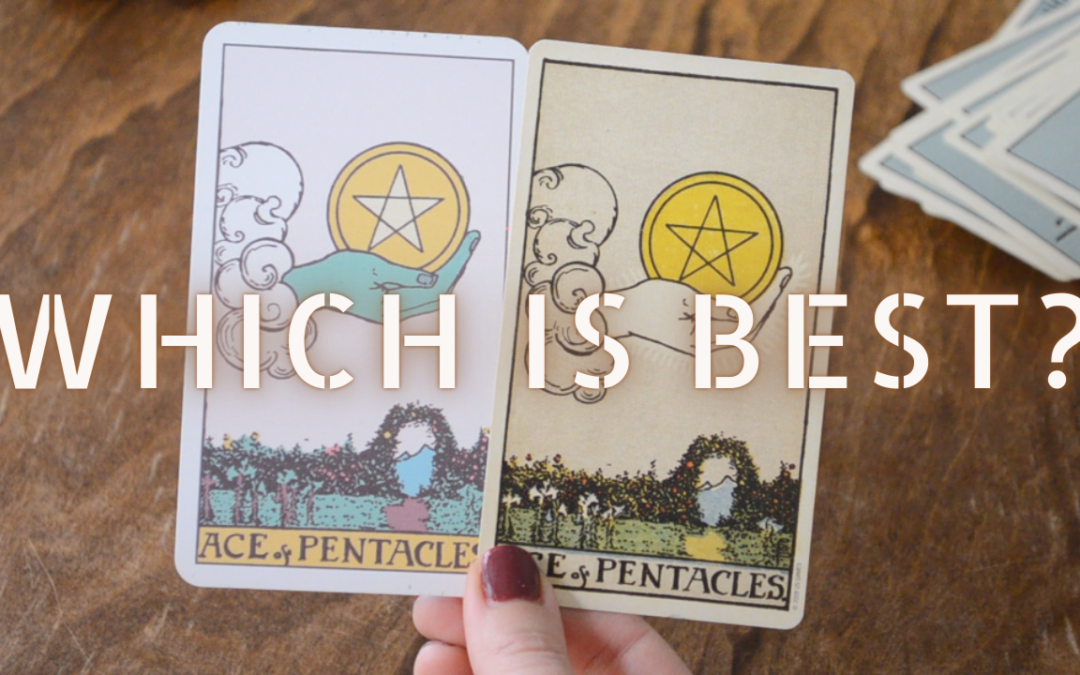
Comparing my fave versions of the Waite-Smith tarot
Just a lil’ flip through of my two favorite versions of this classic tarot deck 🙂
Begin or deepen your tarot studies with
Foundational Tarot, my free video course!
Join the email list for instant access.
We need to talk about ‘The Tarot Handbook’ + tarot meditation for anxiety
Heya!
I’ve been going through a lot this year but I have posted a few videos to YouTube that never made it to my blog. So let’s round up a couple here.
First up, we need to talk about ‘The Tarot Handbook’ by Angeles Arrien. This book is the genesis of many tarot concepts we now take for granted (such as tarot birth cards) and I don’t think it gets enough credit. So let’s talk about it!
And in this next video I share a tarot-infused visualization for anxiety. This has helped me quite a lot this year. I also share some personal updates.
Begin or deepen your tarot studies with
Foundational Tarot, my free video course!
Join the email list for instant access.
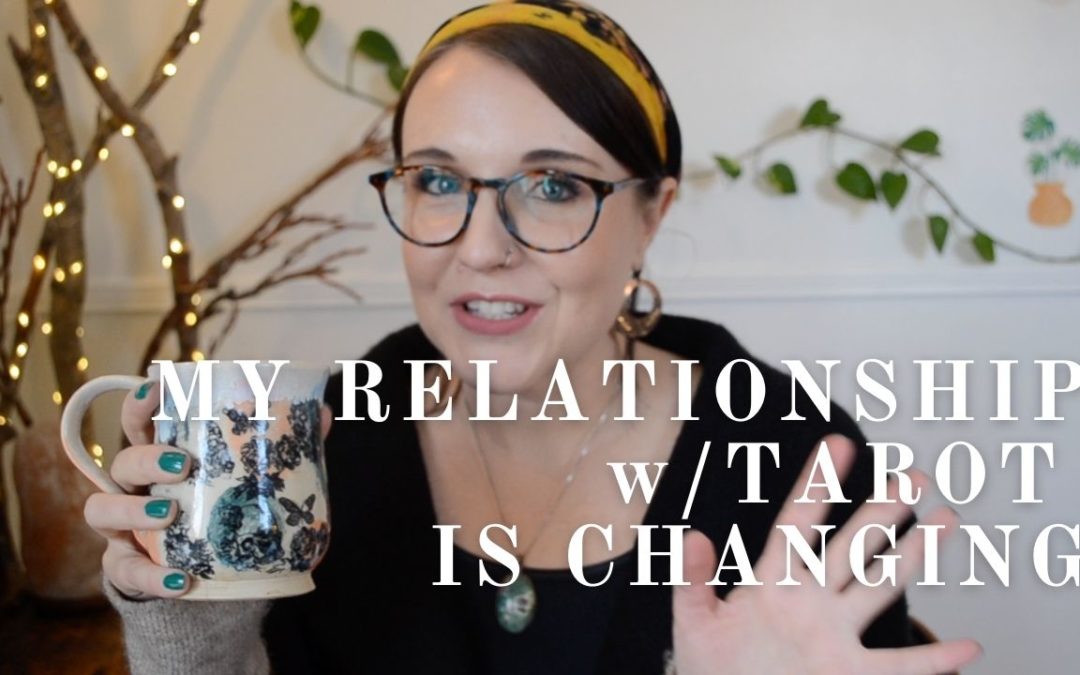
My relationship w/tarot is changing
Lately I’ve found myself processing some shifts in both my relationship to the cards themselves, as well as my relationship to the tarot community. So I made a video to have a chat about this, and you can watch it here.
To make sure you’re aware, I want to mention one of the biggest things I talk about in the video which is that I QUIT INSTAGRAM!
The inundation of scammers on this platform was the last straw for me (but not the only reason). In case you weren’t aware, scammers have been targeting the tarot/witchy community on Instagram for months. They set up a shell profile with a similar username, steal the reader’s photos, and then reach out to the reader’s followers via DMs to solicit readings. Then, of course, they take your money and run.
This is something to watch out for if you’re still on Instagram. A trustworthy reader will NEVER DM YOU FOR A READING. When you encounter scammer profiles you can report the account to Instagram… at least in theory. In reality, Instagram has basically ignored these reports. I suppose it’s not surprising that the platform that knows they are harming young girls’ mental health and did nothing about THAT, isn’t doing anything to resolve scamming in the tarot community.
On a somewhat related note, in this video I also spill the tea on something tarot-reader specific that’s been annoying me on social media lately. It felt good to get that off my chest!
Anyhow, I won’t say too much else here for now as there are plenty other thoughts on offer in the video itself.
I hope you are doing well, thank you for being here, and I look forward to connecting with you again soon!
Sign up for email updates and get
Foundational Tarot, a free video course!
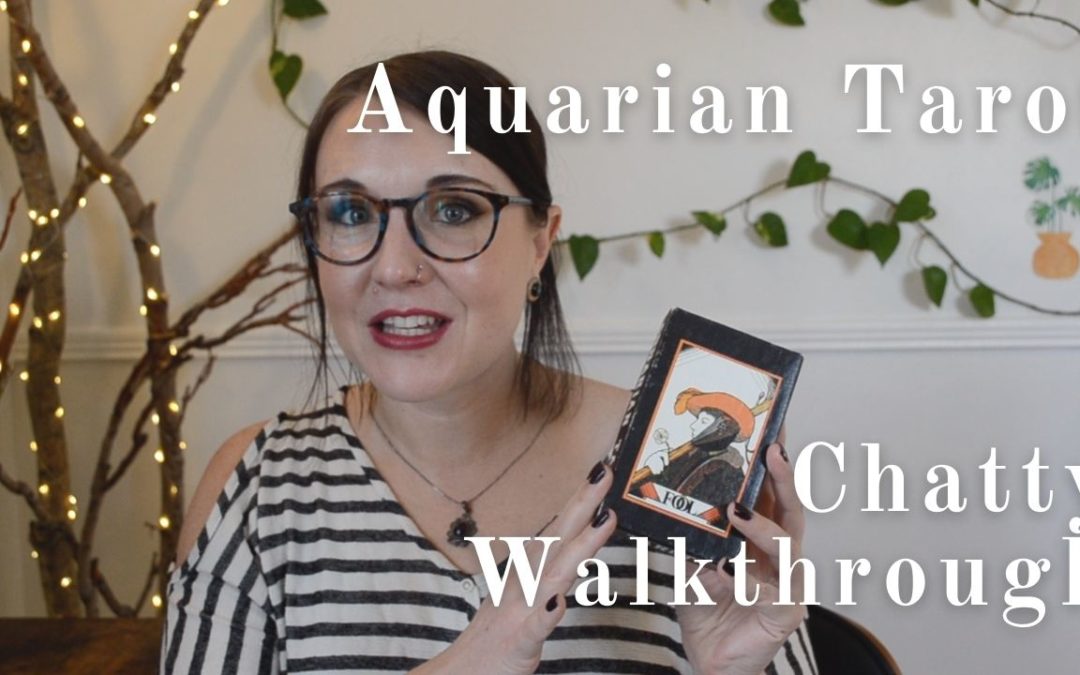
Journey to 1970 w/ the Aquarian Tarot
Every now and then I get on a kick of scrolling through eBay looking for old tarot decks. This is how I recently acquired a first printing of the Aquarian Tarot, which came out in 1970. Join me for a chatty video walking through the deck and speculating on what it was like to be a tarot reader at that time.
I bought this deck on a whim and didn’t expect to like it very much. But as I explored the cards whilst filming, you’ll see me slowly but surely become actually pretty smitten! Sure, it’s mostly a RWS clone. But with its art deco influence and retro color palate and a few interesting diversions from RWS imagery, the Aquarian Tarot certainly has a charm.I did have to brave a battle with tech issues + a cat intrusion while filming, but somehow I made it through and I hope it might be of some interest to you, lolllll.
Sign up for email updates and get
Foundational Tarot, a free video course!
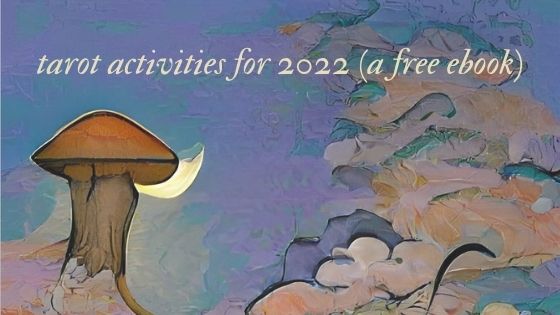
Tarot Activities for 2022 (free ebook)
So, here we are my dear. The beginning of another new year. Welcome, 2022! What I present to you here is of the ‘better late than never’ variety, but I hope you will find something of value in it nonetheless.
You may recall that in years past I created an ebook series called Dreams & Themes around this time of year. I have decided to retire that series, but wanted to do a little something in its honor.
So I’ve created a free mini ebook with some tarot activities to guide you in integrating 2021 and facing forward to 2022! These are modified versions of favorite activities from previous editions of Dreams & Themes and I hope you enjoy them as much as I do.
You can download your free ebook HERE.
This is of course optional, but if you find enrichment from the ebook you might choose to place an offering in my tip jar.
Sending you warm and cozy wishes as your year begins to take shape!
Sign up for email updates and get
Foundational Tarot, a free video course!
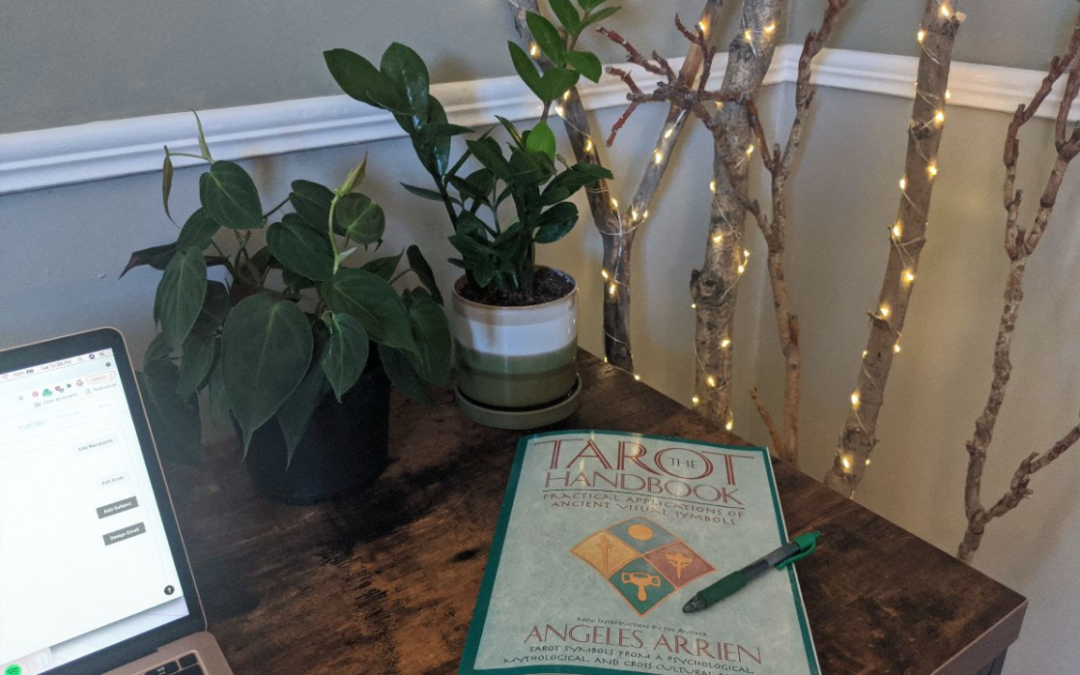
stimulate/motivate/generate: a tarot spread
Equinox blessings…
It’s not that I’m SUPER dedicated to following the wheel of the year, but I’m usually at least somewhat cognizant of it. But I’ve felt less in synch with it than usual this year and I think this is a common experience lately (my friend Áine mentioned the same thing in a recent video).
I guess I’ve actually felt less in synch with everything than usual lately. I’m just…tired. So tired. I think we all are, to different extents and for different reasons. There’s been a lot of think pieces out there about surge capacity (human beings’ ability to take on additional stress during crises, and how we’ve all depleted this reserve) and ambivalent loss (loss that does not have a clear ending or resolution) and I know that’s part of the tiredness.
Even if, like me, you’ve been lucky enough to be physically healthy and have relative stability, the past couple years have just been… a lot.
BUT! Before you click away from this post, be assured that I’m not here today just to wallow in collective gloom. All of this was actually a lead up to say that I’m personally actually feeling a little bit…better lately. A little more in tune with possibility. A little more open to different perspectives.
I finally feel some stuff shifting in me. I’m a little less tired and something is activating. This happens to coincide with the autumn equinox.
Last week I picked up a new to me book, The Tarot Handbook by Angeles Arrien. Originally published in 1987, some of the content feels out of tune with the current zeitgeist, but there’s still some really interesting tidbits I’m finding.
As one example, there’s a phrase Arrien uses when talking about the transition from the Moon to the Sun in the major arcana that pinged something in me: “making choices that honor our authenticity rather than our dutifullness, we are able to be natural generators, motivators, and stimulators.”
Generate. Motivate. Stimulate. Those are the three words that hooked me and I thought…this needs to be a spread. So I switched the order around because it makes more sense to me like this: stimulate (the beginning, the initial spark), motivate (the follow through, tending and developing the initial stimulation), generate (the transformation, what is activated through this process).
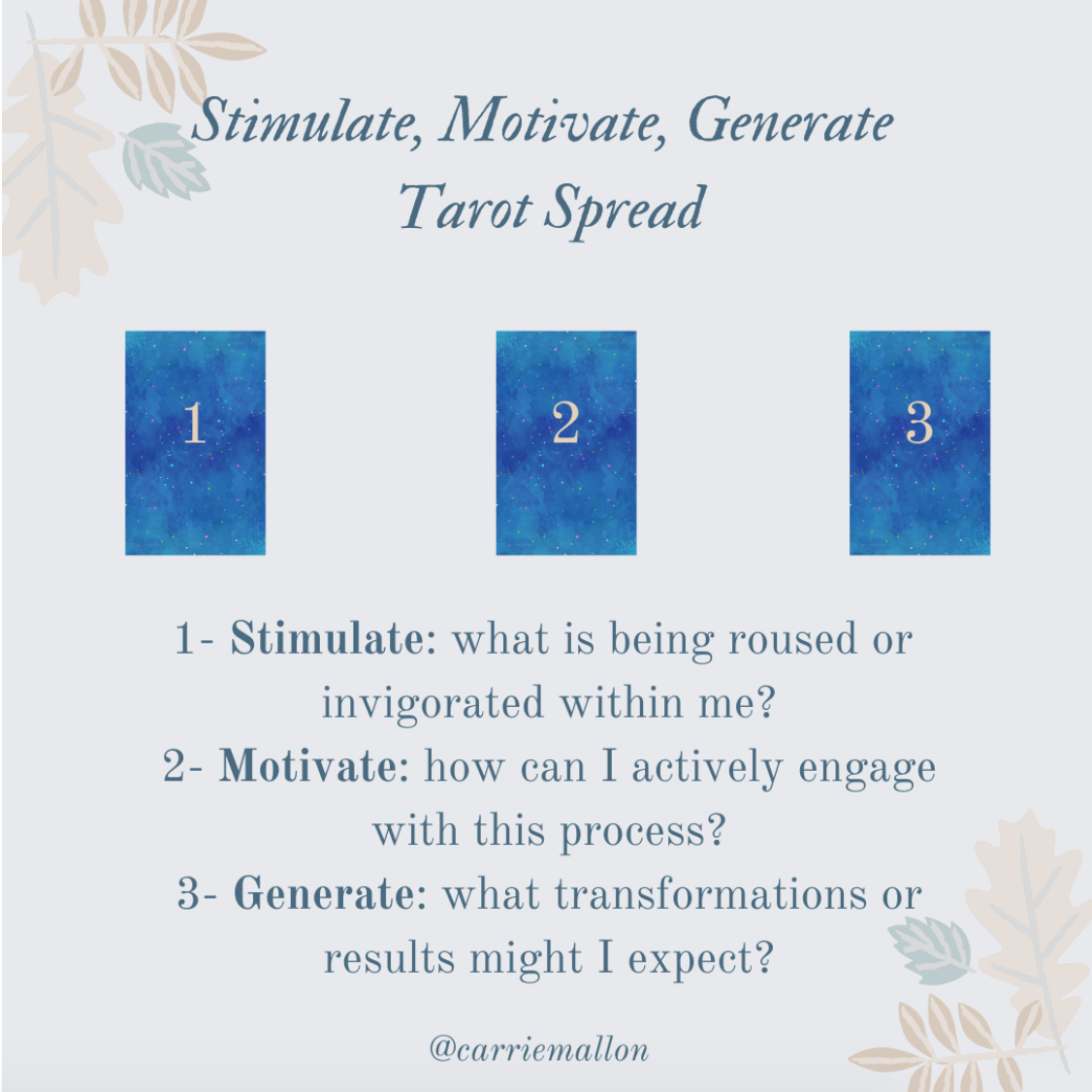
Some might say this would make more sense were we dealing with the energy of the summer solstice, not the autumn equinox (Arrien did pen this phrase in relation to the Sun card, after all). To which I say: fair point, but again: I’m kind of feeling out of synch, and this spread seems like something that could be fruitful for me right now.
I’m going to give it a go here and share my thoughts with you below. Perhaps it’s a spread you might like to try for yourself, too. I’ll be using the Pastel Smith-Waite tarot.
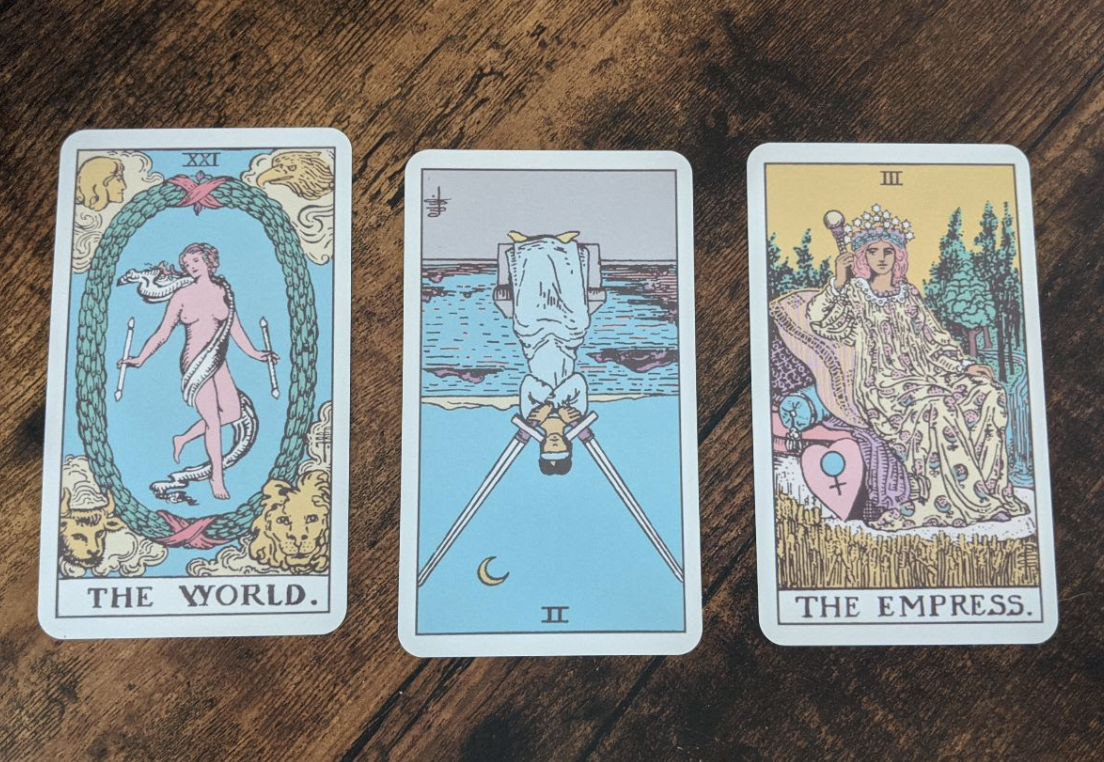
Stimulate: The World
Motivate: Two of Swords rx
Generate: The Empress
Sometimes you lay out a spread and immediately feel this sense of yesness, and that’s what’s happening to me right now.
What is being stimulated is not something new, but a return to form. The World represents my inherent wholeness and completeness, that which can never truly be taken away, only obscured or temporarily forgotten. At this moment, what is being stimulated is my memory of this wholeness. And there’s various levels to this memory. On the surface, I’m reconnecting with memories of who I am, what I value, what is meaningful to me.
But I’m also experiencing memory that goes beyond my conscious mind, beyond my sense of self and identity. It is what could be considered a transpersonal memory (transpersonal: “of, denoting, or dealing with states or areas of consciousness beyond the limits of personal identity” via dictionary).
These two levels of memory work together in this card, keeping me grounded in a sense of being Carrie Mallon, while at the same time remembering this is only one aspect of the bigger picture of Who I Am.
It’s a nice card to see here because for quite some time now I think I have been stuck too much in separation and quite disconnected from any memory or awareness of the transpersonal. That fog has moved some now, making space for the blue sky to shine through…
…which connects to the imagery in the Two of Swords, another blue sky is present here. This card speaks to how I can actively engage with remembering my wholeness. And I think the message is: by practicing selective attention (“the ability to select and preferentially process specific information while simultaneously suppressing the processing of irrelevant, competing distractors” via PNAS).
Often the Two of Swords is framed as avoidance but sometimes avoiding thinking about things is necessary. In fact, our brains flat out could not function if they did not avoid processing certain information.
One specific way I could follow the advice here: spend less time on social media! Story of my damn life. Every few months I’m like “should I just burn all my social media accounts to the ground?” Then five minutes later I’m scrolling through TikTok again. Maybe this time I’ll do a better job on following through here because I know that part of the tiredness I described earlier is caused by the constant barrage of opinions, information and external energy that comes at me like a firehose every time I touch my phone.
Selective attention would be helpful right about now, indeed.
It’s kind of funny because I mentioned some aspects of this book I’m reading being “out of tune with the current zeitgeist” but this card reminds me that it’s also possible to be TOO in tune with the current zeitgeist. I do think there’s some truth to the idea that social media encourages groupthink. Sometimes there’s a sense of fear that I’ll say something which isn’t phrased in the right way or which is out of step with what folks have decided is the “correct” opinion and in turn I will be exiled.
I mean, don’t get me wrong, I’m all for calling out problematic shit and being open to evolving my mindset, but it doesn’t ALWAYS feel like that’s what’s happening on social media. Through selective attention, I can discern what opinions actually ring true to me. Through selective attention, I can let information move through my own unique processing mechanisms, and express things in a way that is authentic to Who I Am. Not just a regurgitation of prepackaged viewpoints from infographics on Instagram.
Anyyyywaaayyyy… I’ll leave this there for now because this is another thing there’s already eight million think pieces about and it’s not something I want to go further into at this moment.
The point here, is even though it does take a lot of resolve to be more selective in my attention (like how much strength it must take this person to hold up those two swords) I’ll be more available to the Wholeness of the World if I take on this advice.
I have to say, seeing the Empress in the Generate position is a delightful synchronicity, since the Empress IS generative (“capable of producing and creating” via dictionary).
Sidenote: why do I keep inserting definitions? No real reason, just vibing with it today.
What I’m noticing the most right now is just how…comfortable the Empress is in their own skin, and their environment. The Empress isn’t trying to impress anyone or jump through hoops for recognition. The Empress is simply and gloriously embodied in who she is. She shows what is available to me: a calm, grounded authenticity.
Much like the World, the Empress is a return to form. I have experienced phases where I did feel embodied, where I did feel grounded and authentic. And the Empress is here like “yeah. That’s your birthright. Let that memory move through you. Do that selective attention thing and come back to this.” Then I join her, and to take this all full circle, I move forward “making choices that honor (my) authenticity rather than (my) dutifullness.”
Well, that was a journey. Thank you if you made it this far with me, I really do appreciate it. I hesitate to promise more consistency in my blogs/newsletters because it seems every time I promise that I fall short. But I will say that as attested to by this spread, I am finally feeling like I have more to say. So perhaps you’ll hear from me again sooner rather than later. Until then, take good care.
Sign up for email updates and get
Foundational Tarot, a free video course!
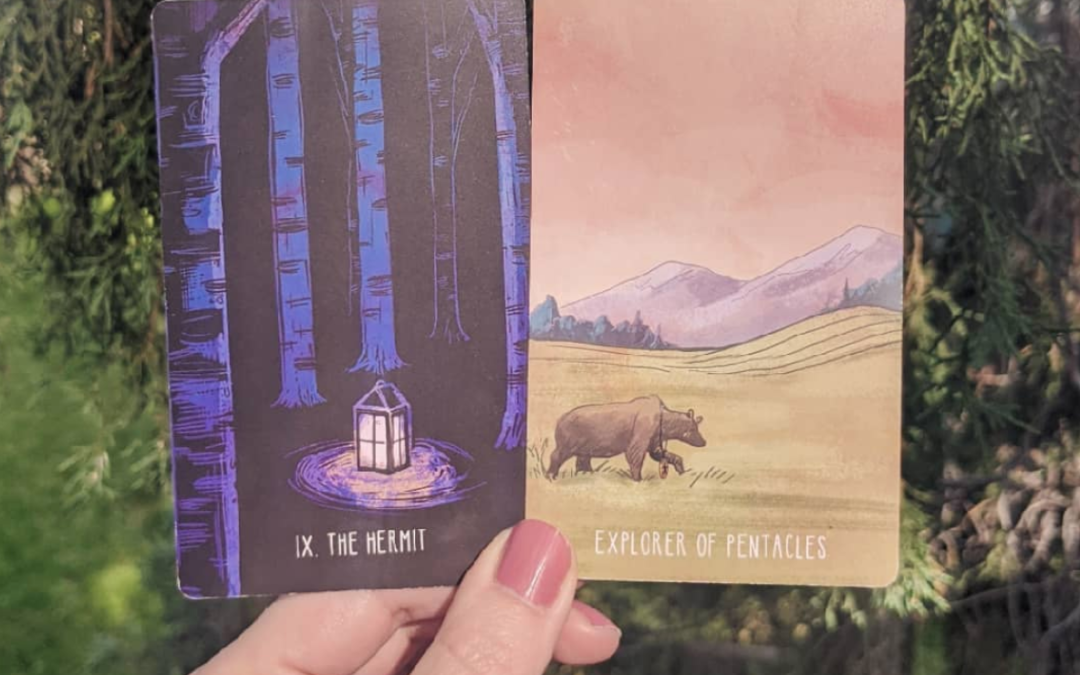
peeking out of the cave
I jotted down some quick notes on this pair in my morning pages (and also shared them on Instagram):
Going places and doing things alone can be quite satisfying. The solitary path is expansive and centering. Having the space to find your own way forward – without rushing or conforming – is a gift. So take the long way around. Sometimes your own slow scenic route is exactly what your soul and body need.
As the day went on I kept thinking back to this draw and some additional messages came to the surface. Most notably, I kept thinking about the order: The Hermit, then the Explorer of Pentacles. Visually, it’s almost like the bear has been in hibernation and is now venturing into the wider landscape. Which is pretty fitting for how I’ve been feeling lately, slowly doing a few more “normal” things like going to bars and seeing friends and family now that myself and many of my loved ones are fully vaccinated.
Visually, the bear is on the edge of the card closest to the Hermit, so it’s like she’s just peeking out of that Hermit cove. Juuuuust starting to move slowly into what might be out there. In her own time, at her own pace.
A thing I’ve thought a lot about over the past year is: what aspects of ‘normal’ do I not WANT to go back to? In what ways do I want to sprawl out not into the way things were, but the way things will be? It’s something I’m now slowly figuring out through direct experience.
Another question I’ve been mulling over – maybe kind of related to all this – is what do I want to share with the world, and what do I want to just be mine? This is part of why it’s been a while since I wrote a more personal, chatty post like this.
Most of what I’ve shared online over the past few months has been more directly tarot related – like all those Instagram lives I did about reading reversals, court cards, and spread creation (all of which are available on my IGTV). In a way it feels safer to be in ‘teacher mode’ and not sharing so much of my own journey. I think it’s good to have boundaries.
But I also do miss doing more of this type of thing, just rambling, talking about my personal tarot draws and my existential angst and such. So maybe (probably) I will continue to share a mixture of things. Cuz boundaries are good, but vulnerability is good too. I can have both, and you can too.
Alright! From here, I want to share more about a few exciting things I’ve got on the horizon.
The Witch City Tarot + Divination Gathering is happening virtually this year, which in a way is a really good thing because it means you can attend from anywhere in the world. Happening July 23-25, learn more or get a weekend pass here.
I’m looking forward to my presentation, titled ‘Telling a New Story With Tarot.’ And I’m really looking forward to the whole line up of amazing presenters, ranging in scope from tarot deck creation to herbalism to ritual to the creative process. Eventually the fine folks organizing this event will have the option to buy tickets for individual presentations if you just want to see mine, but honestly they’re all going to be great and you can buy a full weekend pass right now so probably you should just do that, I say! Support weird, wild, independent witchery.
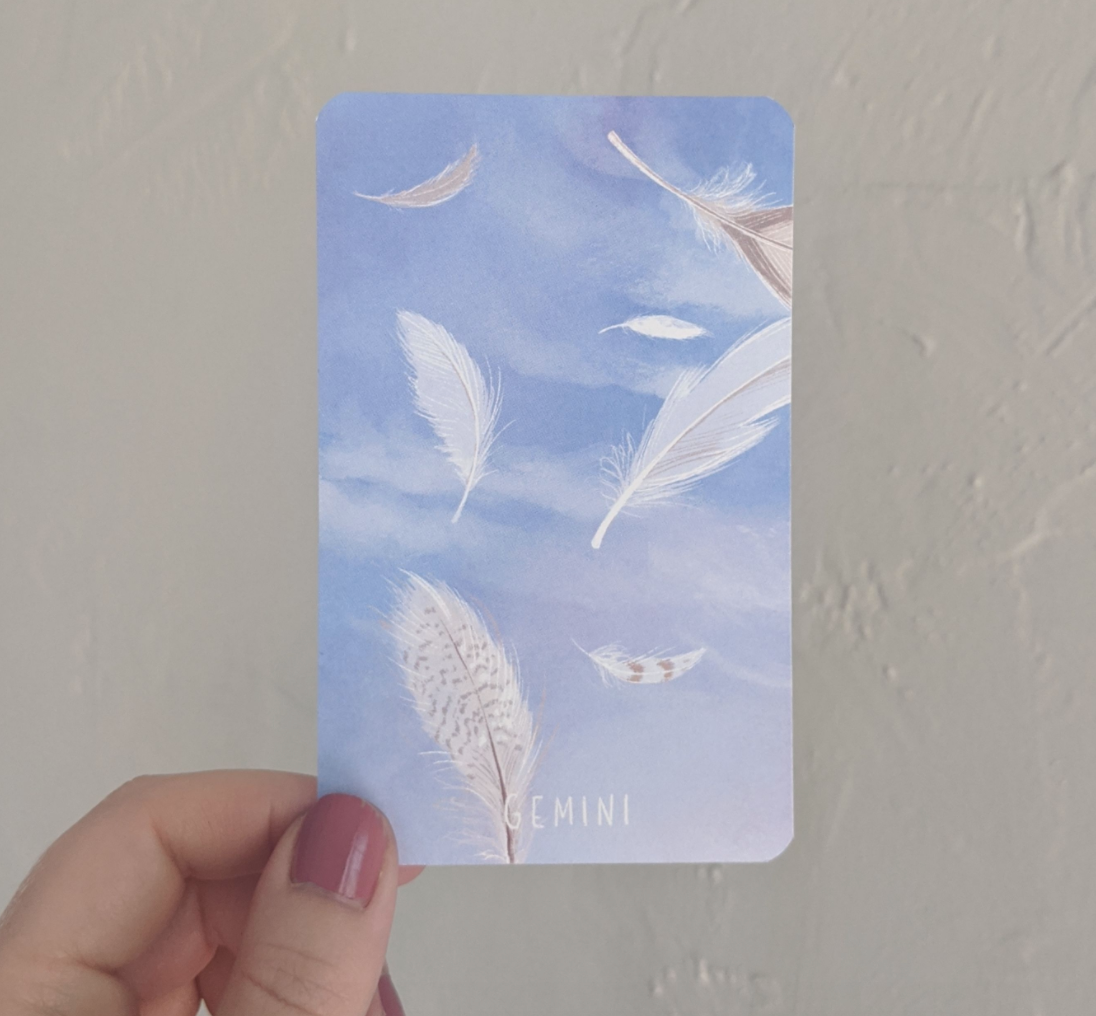
If you haven’t heard, let me tell you more about this. One of my personal favorite decks, the now out of print Spolia Tarot, took inspiration from an older cartomancy system called Minchiate. While related to tarot, Minchiate packs contained additional cards for the four elements, twelve zodiac signs, and classic virtues.
Our Spacious Tarot expansion pack is an homage to these older decks and will contain 22 cards: the elements + zodiac signs, and instead of depicting the classic virtues we will have cards that reflect modern values and the vibe of the Spacious Tarot. The expansion pack can be mixed right in and used along side the tarot deck, or can be kept separate and used kind of like an oracle deck.
We hope to release the expansion pack before the end of this year, but we’ll see how that goes! Gotta trust the pace of the creative process (and not to mention the production process, once we reach that point).
I have to say, creating the zodiac cards has been quite daunting for me. I love astrology, but every time I’ve tried to get serious about learning it more in depth I get overwhelmed and give up. Thankfully my friend Shonna recommended Steven Forrest’s book ‘The Inner Sky’ and it’s really helped so many things click into place for me.
Here’s what I shared about our Gemini card on The Spacious Tarot Instagram, inspired by what I’ve learned from Steven Forrest:
Gemini energy is communicative yet scattered, always in motion. In awe of the variety of life.
Gemini notices details…like the feathers here…but may be challenged to contextualize bits and bobs into a coherent whole.
Gemini is effervescent and always inquiring. Gifted in unraveling layers of lofty ideas, yet prone to flights of fancy.
Exemplifying curiosity, Gemini is the gift of perceiving that which might otherwise go right over your head.
I’m still a little nervous about sharing more of these cards, but I’m also grateful for this creative challenge, and I’m very pleased to finally be deepening my astrology knowledge. I hereby officially upgrade myself from Astrology n00b to Astrology beginner.
Another big ‘behind the scenes’ thing happening with Spacious Creations is we are officially hiring a fulfillment center to take over the shipping process. This doesn’t change anything for our customers, but is a pretty huge change for me as I’ve been doing allllllll the shipping out of my back bedroom ever since we launched the deck. The transition is still a few months away but I’m already looking forward to having more time to work on creative projects and less time hunched over folding, labeling and sorting boxes.
Mostly, Annie and I are both GRATEFUL that the initial tarot deck has been so well received, grateful to have help with the arduous task of shipping, and grateful that we’re now able to focus on making something new.
And one more note before we wrap up the journey of this post: I’m still open for tarot reading sessions and I actually have quite a lot of availability in June. Let’s explore some cards together? All the booking info is here.
That’s it for now. Thanks for being here! Oh and hey, happy PRIDE month! Take good care and seek joy because you deserve it. See ya next time.
Begin or deepen your tarot studies with
Foundational Tarot, my free video course!
Join the email list for instant access.
The 4 Styles of Reading Tarot: a free workshop
Sign up for email updates and get
Foundational Tarot, a free video course!
Carrie Mallon
Header art from The Spacious Tarot illustrated by Annie Ruygt
All site content © Carrie Mallon LLC 2014-2019
Sign up for weekly updates


 I'm a tarot reader and mentor.
I'm a tarot reader and mentor. 
